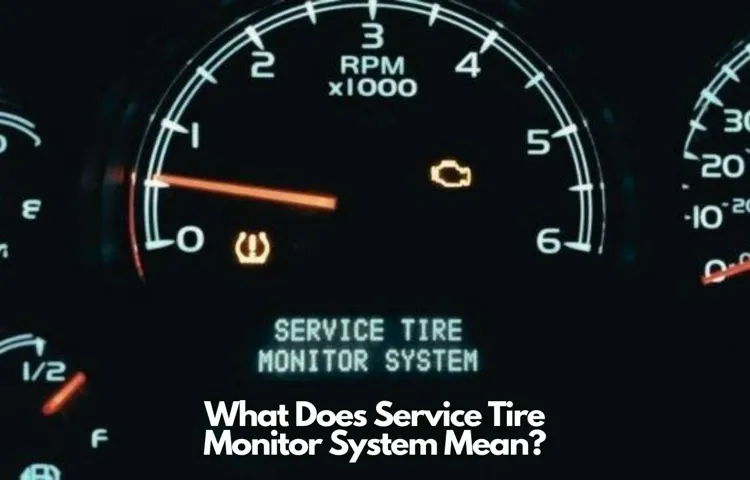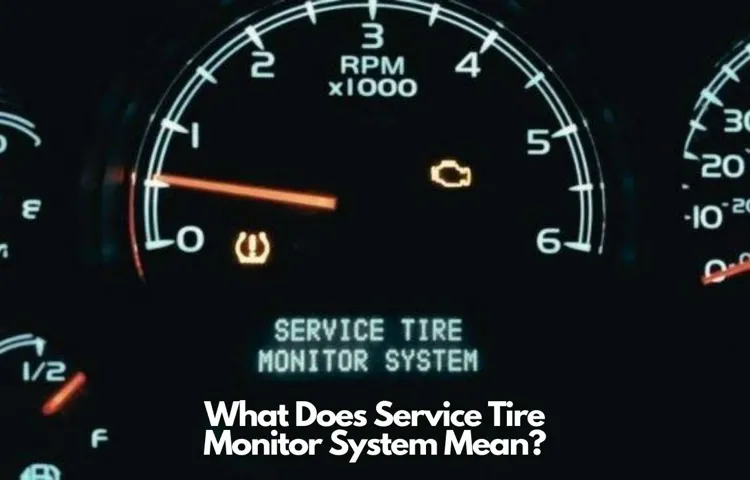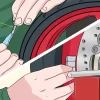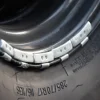Have you ever seen the “Service Tire Monitor System” light illuminating on your dashboard and wondered what it means? It can be a confusing experience if you’re not familiar with how your car operates, but don’t worry, we’re here to help. The Service Tire Monitor System is a safety feature built into many modern vehicles, designed to alert you to potential problems with your tires. When this light appears, it’s important to take action quickly to ensure your safety on the road.
In this blog, we’ll explore what the Service Tire Monitor System is, why it’s important, and what you should do if you see this light come on. So, buckle up and let’s dive into the world of tire safety!
Table of Contents
Overview
Have you ever seen the “Service Tire Monitor System” light illuminate on your vehicle’s dashboard? This indicator light appears when there is an issue with one or more of your tire pressure monitoring sensors, and it’s important not to ignore it. These sensors are responsible for measuring the air pressure in your tires and relaying that information to your vehicle’s computer system. When a tire’s pressure is too low or too high, it can cause poor handling and reduced fuel efficiency, as well as increase your risk for a blowout or flat tire.
If you see this warning light, it’s essential that you have your tires inspected and serviced by a certified mechanic to ensure that they are functioning correctly. Don’t put your safety at risk – address any issues with your Service Tire Monitor System promptly.
Explanation of Tire Monitor System
Tire Monitor System When it comes to safety behind the wheel, monitoring the condition of your tires is critical. That’s where Tire Monitor Systems come into play. A Tire Monitor System is a technology-based solution that monitors the pressure and temperature of each tire and sends alerts to the driver if there are any defects.
This system is incredibly useful as it reduces the chances of tire failure, blowouts, and other related hazards. Nowadays, it has become a standard feature in most new vehicles, and it has revolutionized the way we monitor the condition of our tires. With this system in place, drivers can confidently hit the road knowing that they won’t be caught off guard by any unexpected tire issues.
In short, the Tire Monitor System is an essential tool for improving road safety and driver comfort.

Causes of Service Tire Monitor System Message
If you’re driving along and suddenly see the “Service Tire Monitor System” message pop up on your dashboard, there are a few potential causes to consider. Typically, this message means that one or more of the sensors in your vehicle’s tires is not working properly. These sensors are responsible for tracking tire pressure and temperature, both of which are important for maintaining safety on the road.
Other potential causes of this message include faulty wiring, a dead battery in the sensor itself, or even just a worn-down tire. It’s important to address this issue as soon as possible to ensure that your vehicle is safe and roadworthy. Thankfully, many automotive repair shops are equipped to diagnose and fix problems with tire monitor systems, so don’t hesitate to take your car in for a check-up if this message appears.
By doing so, you can ensure that you and your passengers stay safe on the road.
How to Respond
When you see the message “Service Tire Monitor System” on your car’s dashboard, it means that your vehicle’s computer has detected a potential issue with the tire pressure monitoring sensors installed in your tires. If one or more of these sensors are malfunctioning or need to be replaced, this message will appear on your dashboard. It’s essential to have your vehicle checked by a professional as soon as you see this message, as driving with an inaccurate tire pressure can cause a variety of safety concerns.
Low tire pressure can cause tires to wear out more quickly and can affect the handling and stability of your vehicle, leading to increased risks of accidents. So, when you see “Service Tire Monitor System,” it’s best to take your car to a mechanic and get it fixed as soon as possible.
Check Tire Pressure
Checking tire pressure is an essential aspect of car maintenance that should never be taken for granted. Keeping the right tire pressure is crucial to ensuring safe and smooth driving. So, if you notice your car pulling in different directions or your tires looking flat, it’s time to take action.
The first step is to check your car’s manual for the recommended tire pressure range based on the temperature and load. Then, use a tire pressure gauge to check the pressure in all four tires, including your spare. If the pressure is lower than the recommended range, add air until the reading is within the correct range.
Remember, underinflated tires can cause them to wear out faster and reduce fuel efficiency. On the other hand, overinflated tires can be risky as they are at risk of bursting. Make it a habit to check your tire pressure regularly, ideally once a month, to ensure your safety and save on costly repairs.
Inspect Tires for Damage
When it comes to inspecting your tires for damage, there are a few things you should keep in mind. First, it’s always a good idea to give your tires a visual check regularly. Look for any signs of wear or damage, such as cracks or bulges.
If you notice anything that looks suspicious, take your vehicle to a professional tire shop to have it checked out. It’s also a good idea to check the tire pressure regularly, as properly inflated tires not only help you avoid damage but will also save you money on fuel. Additionally, it’s important to keep an eye out for any nails or other objects that may have punctured your tire.
Driving with a punctured tire not only increases the risk of a blowout but can also cause irreparable damage to the tire. If you’re unsure whether your tire has been punctured, try spraying some soapy water on it and look for any bubbles – if you see any, it’s likely that your tire has been punctured and needs to be repaired or replaced. By staying vigilant and regularly inspecting your tires, you can help prevent accidents and ensure your vehicle is always running smoothly.
Reset Tire Monitor System
If you’re wondering how to reset your tire monitor system, there are a few easy steps to follow. First, determine the type of system your car has. Some models will have a reset button or require you to use the infotainment system to access the sensor settings.
Once you’ve figured out how to access the sensor settings, make sure your tires are properly inflated to the recommended PSI. Then, follow the on-screen instructions to reset the system. It’s important to note that not all tire monitor systems can be reset, so if you’re having trouble, it may be best to consult your car’s manual or take it to a certified mechanic.
Remember that regularly checking your tire pressure and keeping them properly inflated can help prevent unnecessary wear and improve your car’s fuel efficiency.
Conclusion
In conclusion, the “Service Tire Monitor System” message is like your car’s little helper, reminding you to check on the condition of your tires and prevent potential issues on the road. It’s kind of like having your own personal tire concierge, ensuring that your ride stays safe and smooth. So the next time you see that message pop up on your dashboard, don’t ignore it – thank your tire monitor system for looking out for you!”
Importance of Service Tire Monitor System
As a driver, it is important to understand the significance of the Service Tire Monitor System. This system is designed to alert drivers when tire pressure is low, preventing potential safety hazards. When prompted, it is crucial to take immediate action and add air to the underinflated tire(s).
Driving on low tire pressure can lead to decreased fuel efficiency, tire wear, and even accidents. It is also important to regularly check tire pressure and visually inspect the condition of each tire to ensure they are functioning properly. Just like an annual physical exam is important for our health, regular maintenance checks on our vehicles can prevent costly repairs and ensure a safer driving experience.
So, next time the Service Tire Monitor System light illuminates on your dashboard, don’t hesitate to take action. Your safety and the safety of others on the road depend on it.
Safety Benefits of Maintaining Tire Monitor System
Maintaining a tire monitor system has several safety benefits that we should never overlook. Firstly, it can prevent blowouts by notifying the driver when the tire pressure drops below the recommended level. This significantly reduces the risk of accidents, especially during long road trips or when hauling heavy loads.
Additionally, maintaining a tire monitor system can also detect any abnormal tire vibrations that may indicate a puncture or other tire damage. By detecting small issues before they escalate into bigger problems, a tire monitor system can save you money on repair costs. So, how should you respond to a tire monitor system alert? Firstly, safely pull over to a location where you can check your tires.
Next, visually inspect each tire and check the pressure using a tire gauge. If a tire is visibly flat or damaged, replace it or fix it immediately. If the tire pressure is low, inflate it to match the recommended level.
By following these guidelines, you’re helping to ensure that you and your passengers remain safe on the road while also extending the lifespan of your tires. Remember, safety is always a top priority when driving, and maintaining a tire monitor system can make all the difference.
FAQs
What is a tire pressure monitoring system (TPMS)?
A TPMS is an electronic system that monitors the tire pressure of a vehicle and sends alerts to the driver in case of below-normal tire pressure.
How does a TPMS work?
TPMS works by using sensors mounted inside the tires that collect data, which is transmitted wirelessly to a control module. The module then analyzes the data and sends alerts to the driver in case of low tire pressure.
What does “service tire monitor system” mean?
“Service tire monitor system” means that there is an issue or fault with one or more tire sensors, and the system needs to be checked or serviced.
What are the benefits of a TPMS?
A TPMS helps to ensure optimal tire pressure, improve fuel efficiency, prolong tire life, and enhance overall vehicle safety.
How often should a TPMS be serviced?
A TPMS should be serviced according to the manufacturer’s recommendations, usually once or twice a year, or after a tire replacement or rotation.
What are some common TPMS issues?
Some common TPMS issues include dead or weak batteries in the sensors, faulty sensors, and signal interference.
Can I drive with a “service tire monitor system” warning?
Yes, but it is important to check the tire pressure manually before driving, as driving with underinflated tires can be dangerous and cause damage to the tires.



